Whole bone testing in small animals: systematic characterization of the mechanical properties of different rodent bones available for rat fracture models
- PMID: 29444703
- PMCID: PMC5813325
- DOI: 10.1186/s40001-018-0307-z
Whole bone testing in small animals: systematic characterization of the mechanical properties of different rodent bones available for rat fracture models
Abstract
Objectives: Rat fracture models are extensively used to characterize normal and pathological bone healing. Despite, systematic research on inter- and intra-individual differences of common rat bones examined is surprisingly not available. Thus, we studied the biomechanical behaviour and radiological characteristics of the humerus, the tibia and the femur of the male Wistar rat-all of which are potentially available in the experimental situation-to identify useful or detrimental biomechanical properties of each bone and to facilitate sample size calculations.
Methods: 40 paired femura, tibiae and humeri of male Wistar rats (10-38 weeks, weight between 240 and 720 g) were analysed by DXA, pQCT scan and three-point-bending. Bearing and loading bars of the biomechanical setup were adapted percentually to the bone's length. Subgroups of light (skeletal immature) rats under 400 g (N = 11, 22 specimens of each bone) and heavy (mature) rats over 400 g (N = 9, 18 specimens of each bone) were formed and evaluated separately.
Results: Radiologically, neither significant differences between left and right bones, nor a specific side preference was evident. Mean side differences of the BMC were relatively small (1-3% measured by DXA and 2.5-5% by pQCT). Over all, bone mineral content (BMC) assessed by DXA and pQCT (TOT CNT, CORT CNT) showed high correlations between each other (BMC vs. TOT and CORT CNT: R2 = 0.94-0.99). The load-displacement diagram showed a typical, reproducible curve for each type of bone. Tibiae were the longest bones (mean 41.8 ± 4.12 mm) followed by femurs (mean 38.9 ± 4.12 mm) and humeri (mean 29.88 ± 3.33 mm). Failure loads and stiffness ranged from 175.4 ± 45.23 N / 315.6 ± 63.00 N/mm for the femurs, 124.6 ± 41.13 N / 260.5 ± 59.97 N/mm for the humeri to 117.1 ± 33.94 N / 143.8 ± 36.99 N/mm for the tibiae. Smallest interindividual differences were observed in failure loads of the femurs (CV% 8.6) and tibiae (CV% 10.7) of heavy animals, light animals showed good consistency in failure loads of the humeri (CV% 7.7). Most consistent results of both sides (left vs. right) in failure loads were provided by the femurs of light animals (mean difference 4.0 ± 2.8%); concerning stiffness, humeri of heavy animals were most consistent (mean difference of 6.2 ± 5%). In general, the failure loads showed strong correlations to the BMC (R2 = 0.85-0.88) whereas stiffness correlated only moderate, except for the humerus (BMC vs. stiffness: R2 = 0.79).
Discussion: Altogether, the rat's femur of mature specimens showed the most accurate and consistent radiological and biomechanical results. In synopsis with the common experimental use enabling comparison among different studies, this bone offers ideal biomechanical conditions for three point bending experiments. This can be explained by the combination of a superior aspect ratio and a round and long, straight morphology, which satisfies the beam criteria more than other bones tested.
Figures


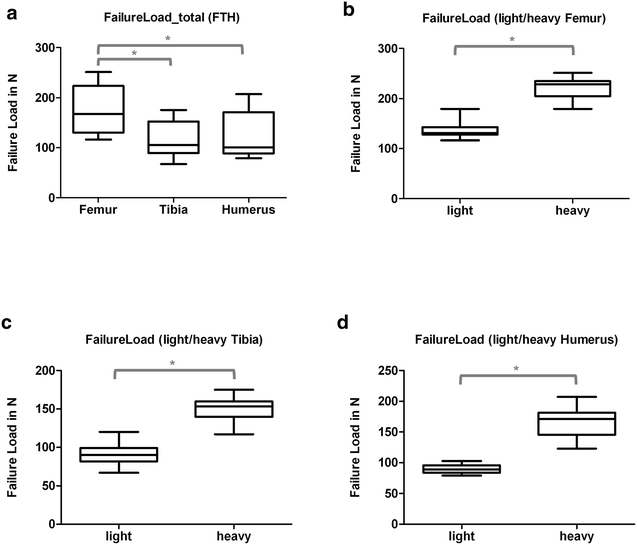
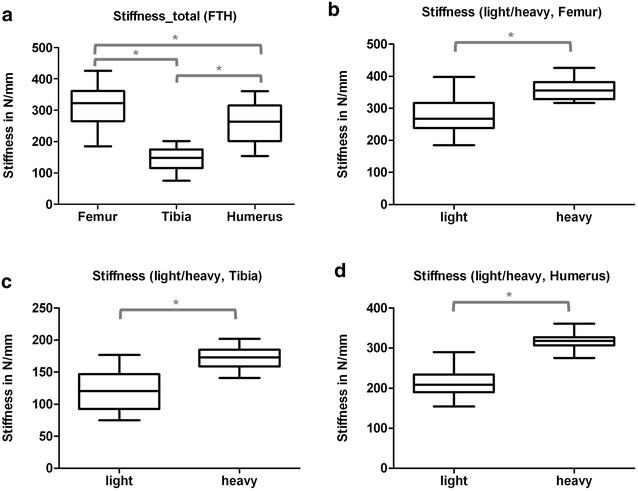
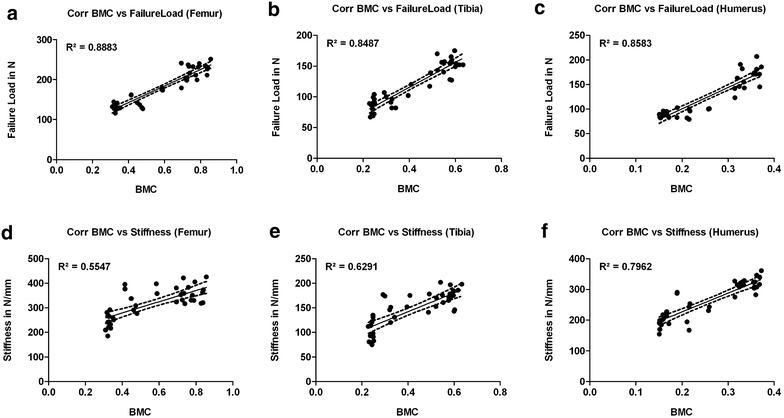
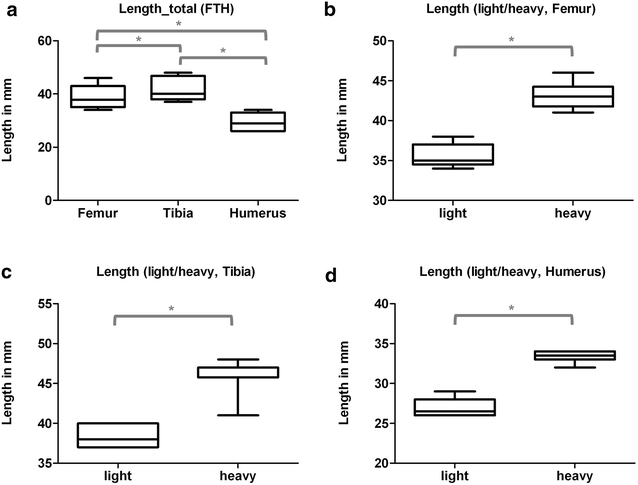
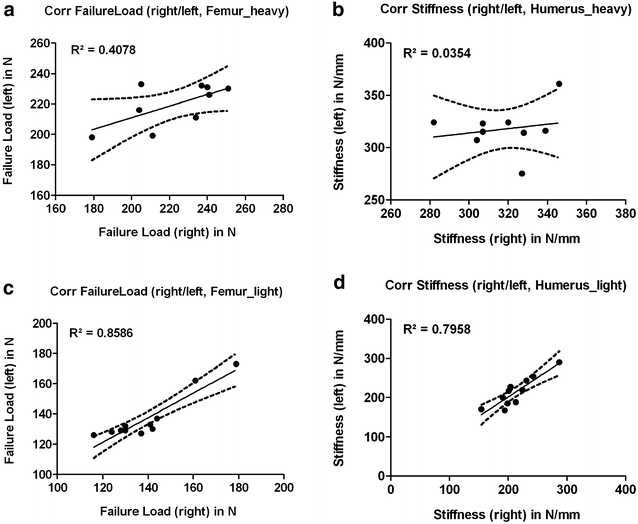
Similar articles
-
Improving results in rat fracture models: enhancing the efficacy of biomechanical testing by a modification of the experimental setup.BMC Musculoskelet Disord. 2018 Jul 19;19(1):243. doi: 10.1186/s12891-018-2155-y. BMC Musculoskelet Disord. 2018. PMID: 30025531 Free PMC article.
-
[Evaluation of bone architecture and biomechanic properties by peripheral quantitative computed tomography in rats].Zhonghua Yi Xue Za Zhi. 2003 May 10;83(9):791-5. Zhonghua Yi Xue Za Zhi. 2003. PMID: 12899761 Chinese.
-
Bone stiffness in children: part II. Objectives criteria for children to assess healing during leg lengthening.J Pediatr Orthop. 2008 Jul-Aug;28(5):538-43. doi: 10.1097/BPO.0b013e31817bb82e. J Pediatr Orthop. 2008. PMID: 18580369
-
Mechanical validation of whole bone composite femur models.J Biomech. 1996 Apr;29(4):525-35. doi: 10.1016/0021-9290(95)00084-4. J Biomech. 1996. PMID: 8964782 Review.
-
Establishing biomechanical mechanisms in mouse models: practical guidelines for systematically evaluating phenotypic changes in the diaphyses of long bones.J Bone Miner Res. 2015 Jun;30(6):951-66. doi: 10.1002/jbmr.2539. J Bone Miner Res. 2015. PMID: 25917136 Free PMC article. Review.
Cited by
-
Effect of L-thyroxine on bone biomechanical and morphometric parameters in rats.BMC Vet Res. 2025 May 19;21(1):358. doi: 10.1186/s12917-025-04816-7. BMC Vet Res. 2025. PMID: 40389947 Free PMC article.
-
Development of a subject-specific finite element analysis workflow to assess local biomechanics during segmental bone defect healing.J Mech Behav Biomed Mater. 2025 Sep;169:107065. doi: 10.1016/j.jmbbm.2025.107065. Epub 2025 May 19. J Mech Behav Biomed Mater. 2025. PMID: 40449116
-
The Effect of Ceratonia siliqua Supplement on Bone Mineral Density in Ovariectomy-induced Osteoporosis in Rats.In Vivo. 2023 Jan-Feb;37(1):270-285. doi: 10.21873/invivo.13077. In Vivo. 2023. PMID: 36593044 Free PMC article.
-
Moderate/subclinical calcium deficiency attenuates trabecular mass, microarchitecture and bone growth in growing rats.Biochem Biophys Rep. 2021 May 27;26:101033. doi: 10.1016/j.bbrep.2021.101033. eCollection 2021 Jul. Biochem Biophys Rep. 2021. PMID: 34124397 Free PMC article.
-
Improving results in rat fracture models: enhancing the efficacy of biomechanical testing by a modification of the experimental setup.BMC Musculoskelet Disord. 2018 Jul 19;19(1):243. doi: 10.1186/s12891-018-2155-y. BMC Musculoskelet Disord. 2018. PMID: 30025531 Free PMC article.
References
MeSH terms
LinkOut - more resources
Full Text Sources
Other Literature Sources
Medical

